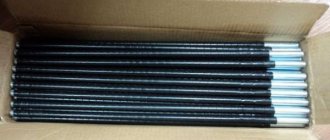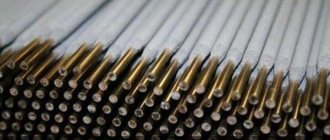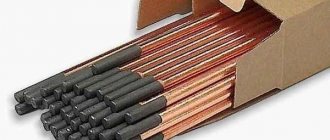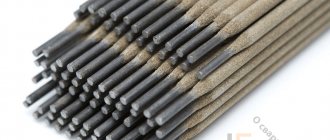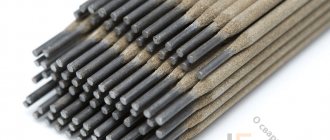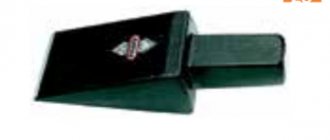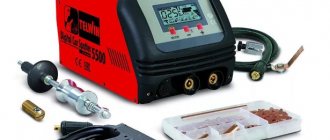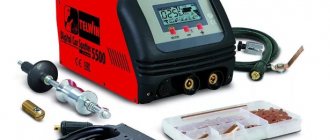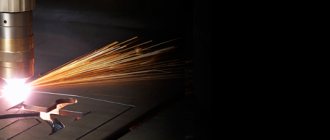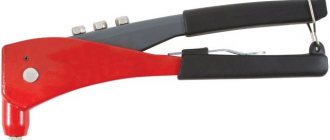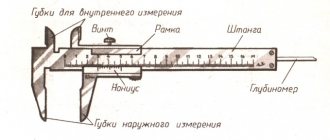Manual arc cutting using electrodes is one of the most popular metal cutting methods. This method is used by both experienced welders and novice welders.
The popularity of this method is due to its relative simplicity: all you need is a welding machine (usually an inverter) and correctly selected electrodes for cutting metal. In this article we will tell you everything about the selection and operation of electrodes used for cutting.
Types of electrodes for cutting
Metal electrodes
Conventional coated metal electrodes are often used for cutting. This can be rutile or basic coating. Overall, the coating results in a smoother cut. The arc burns more stable and does not go out for a long time, the metal practically does not oxidize. But we do not recommend using such electrodes on an ongoing basis, since they are not originally intended for cutting. They can be used to cut cracks or remove seams with defects. We also recommend calcining the electrodes in an oven before starting work.
Carbon electrodes
Cutting metal with a carbon electrode is practically no different from cutting with metal materials. But they are still more intended for cutting. They have one significant advantage: instead of rapidly melting, like metal electrodes, they melt slowly. Because of this, the cut is more accurate.
Another advantage of carbon materials is that they can heat up quite quickly at low current. At the same time, they do not melt up to a temperature of 3000 degrees, so they are consumed quite economically.
Carbon electrode cutting is used for manual arc and oxygen-arc cutting. We recommend setting to straight polarity and constant current. You can set it to variable, but constant is better suited for these purposes.
Tubular electrodes
Tubular electrodes are used in oxygen-arc cutting. They differ from other types of electrodes in that the base is not wire, but a special tube filled with oxygen. The cutting process is similar to the others, but when the metal melts, oxygen begins to be released from the tube. It oxidizes the metal and blows it out, thereby creating a cut. This is an interesting cutting method, but it requires a lot of experience because the arc burns unstable due to the large amount of oxygen produced.
Tungsten non-consumable electrodes
Tungsten electrodes for plasma cutting are used in a protective gas environment. To cut metal, set the amperage to a higher value, more than you use when welding. This way the metal will melt evenly throughout its thickness. In general, tungsten electrodes can be used for work, but they are a very niche material. It will never be universal in your garage.
Price for welding materials
Fill out the form and receive the price list by email.
Until recently, for cutting metals, in practice, only general-purpose welding electrodes were used, which do not provide the required quality of the cut surface and productivity. For cutting, special electrodes are required, which must produce an arc of consistently high thermal power, i.e., allow the use of high current and voltage on the arc. The coating must have high heat resistance and allow the liquid metal to oxidize for easy removal from the cutting site. The listed requirements are met by electrodes of the OZR-1 brand (TU 14-4-321-73) , intended for cutting, gouging, and piercing holes in products made of steel (including corrosion-resistant), cast iron, and copper alloys. The use of electrodes is also advisable for removing defective seams or sections thereof, removing tacks, rivets, bolts, cutting defects, cracks, etc. The purpose of electrodes of the ANR-2 (TU 14-4-682-76) and ANR-2M brands .
Separation and surface cutting (gouging) is carried out in all spatial positions on both direct and alternating current in the following modes depending on the diameter of the electrode: 3 mm - 110-170 A, 4 mm - 180-300 A, 5 mm - 250 -360 A, 6 mm - 350-600 A. The arc voltage when cutting with electrodes of the OZR-1 brand reaches 50-52 V, which exceeds the values obtained both for welding electrodes and for electrodes of the ANR-2 and ANR-2M brands .
Electrodes of the OZR-1 brand have a simple bicomponent coating that does not contain hygienically unfavorable, scarce or expensive components: it consists of hematite and quartz. The oxygen-containing component in the coating of ANR-2 electrodes is manganese ore, which serves as the basis (70%) of the coating. In ANR-2M electrodes, instead of manganese ore, like in OZR-1 electrodes , hematite (60%) is present. When melting electrodes ANR-2, ANR-2M and OZR-1, the total dust emission per kilogram of burned electrodes is 15.9, respectively; 17.2 and 6.1 g, and the content of toxic manganese in it is 10.8; 1.2 and 0%. From a sanitary and hygienic point of view, the use of OZR-1 electrodes is preferable .
The use of special electrodes ensures productivity higher than with mechanical methods of removing defective metal (cutting, grinding), and also provides a significant improvement in working conditions for workers. The cutting speed of cast iron and steel castings is 1.5–2.0 times higher than with carbon electrodes in the same modes during air-arc cutting.
Pros and cons of cutting with electrodes
Any method of cutting metal has its advantages and disadvantages, so cutting with electrodes was no exception. What are the main advantages of this cutting method? Firstly, you do not need to have special equipment or high qualifications to carry out cutting. It is also a relatively safe cutting method, but you still need to follow fire safety regulations.
Among the disadvantages, we note that the cutting speed will directly depend not on your skills and abilities, but on the thickness of the metal. So be patient when cutting thick parts. Also, the quality of the cut leaves much to be desired. The cut is sloppy and uneven. Therefore, this method is not suitable for cutting parts used in the design of swing gates, for example.
Large selection of welding electrodes in Novokuznetsk 8-950-587-78-68 8-909-511-21-45
A clean cut surface is ensured by the presence of oxides in the coating, which prevent particles of molten metal from sticking to it. It is important that when using special electrodes for cutting and gouging that do not contain carbon-containing components in the coating, there is no carburization of the cut edges. This allows you to avoid additional mechanical preparation before subsequent welding.
The use of such electrodes for gouging is of independent interest. The shape of the edges obtained during gouging is close to the requirements of the standards, the cut groove is clean in depth and width, the quality of metal gouging in all spatial positions is good and allows for high-quality formation of the weld without preliminary mechanical cleaning. Gouging productivity up to 50 m/h.
Features of cutting with electrodes
Like any other type of welding work, cutting metal with electrodes has its own characteristics. To make cutting, you must first prepare the device and the metal. Be sure to check the serviceability of your welder and all cables, and do not neglect safety precautions. To ignite the arc, tap the end of the electrode on the metal surface. Experienced welders also use the striking method. Then select the desired operating mode: adjust the current parameter based on the diameter of the electrode and the thickness of the metal. If the metal is thin, then use a 3 mm electrode and increase the diameter as the thickness of the metal increases. When cutting thin metal, you can increase the current setting without fear of ruining the work.
Principle of operation
In order to cut metal using an inverter, you must select the correct current values. This depends on the type of cut, the thickness of the metal and the selected electrode. When separating cutting, the metal sheet should be placed in such a position that the molten metal can flow out freely.
The electrodes must be in a strictly perpendicular position with respect to the surface. If the sheet is located vertically, then the movement of the electrode should be from top to bottom. The electrodes themselves must be thicker than the product being cut. Thin metal can be cut using electrodes with a diameter of 3 millimeters. For thicker ones, electrodes of 4 and 5 millimeters are used.
To eliminate surface defects, surface cutting should be used. In this case, the electrode should be held at a slight angle, five to ten degrees. If it is necessary to make a groove, the electrode must be rocked from one side to the other, gradually immersing it into the cavity being formed.
Electrodes can also be used to cut holes in metal. Melt holes until the desired diameter is achieved. First, burn a small hole, and then gradually expand it. The electrode must be held strictly perpendicular to the surface in which the hole is being cut, otherwise the edges may not be completely smooth. Only minor deviations from a right angle are allowed. Before starting the process, it is necessary to check the serviceability of the equipment used. The arc should be ignited by striking or tapping.
Main selection criteria
Difficulties that arise when choosing are associated with the emergence of a large number of different electrode options. When searching for the most suitable electrode, you should take into account their division into two main groups:
- Melting.
- Non-melting.
The first type of product is represented by a rod of various diameters with a coating made from a special mixture.
Due to the use of a special coating composition, the created arc behaves better at the time of welding. This is why consumable electrodes are often chosen for devices used in manual arc welding. Non-consumable - today are less common, as they are intended for welding work in a special environment. A beginner will not be able to choose them correctly, as they have a large number of features.
The selection of electrodes for welding with an inverter is carried out taking into account the material from which the workpieces to be joined are made. The properties of the metal largely determine the quality of the resulting weld.
Considering how to choose welding electrodes for an inverter, we note the following points:
- The rod for transmitting electricity and stabilizing the arc is selected for each material, taking into account its chemical composition.
- Carbon electrodes are used to connect products made of low-carbon or low-alloy steel.
- If the products to be joined are made of alloy steels, then electrodes of the MP-3, ANO-21, LB-52U and others are used during welding work.
- The best electrodes for inverter welding of other types of metal are considered to be those in the manufacture of which a core made of alloy steel is used, for example, TsL-11.
- The welding method can be used to join elements made of cast iron. In this case, OZCH-2 electrodes are used.
Experienced welders select the consumable material in question also taking into account the conditions under which the resulting product will be used.
Classification according to main characteristics
The consumable material in question is primarily classified according to its intended purpose. There are several main groups of electrodes:
- Designed to work with metals that have a low concentration of carbon and alloying elements.
- For joining heat-resistant steels with a high strength index.
- For working with high-alloy steels, for example, stainless steel, in which the concentration of chromium is high.
- Options designed to work with aluminum or copper.
- A separate group includes electrodes intended for connecting cast iron elements.
- For repair work and metal surfacing.
- Universal type products that are used to work with materials of uncertain chemical composition.
A wide variety of chemicals can be applied to the metal rod. According to the type of coating used, 4 groups of products are distinguished; only two are most widespread:
- Main. Products with a basic coating are widely used. An example would be electrodes of the UONI 13/55 brand. They are used to produce seams with high impact strength, mechanical strength and ductility. In addition, the base coating helps protect the seam from the occurrence of crystallization cracks. The choice of this design option is carried out if you need to obtain a responsible design. A significant drawback is that before welding work, the surface must be thoroughly cleaned: oil stains, rust, and scale can cause the formation of microscopic pores.
- Rutile coating. If it is necessary to make a connection on low-carbon steel, then rutile-type electrodes are often chosen. Let's call the most common brand MP-3. The second type is characterized by easy separability of the forming slag and arc stability when supplied with alternating or direct current. During the welding process, less spatter is generated, and the resulting seam has excellent decorative qualities. In addition, the second type of product is suitable for working with workpieces that have a large layer of rust or contaminants on the surface.
The other two types are extremely rare, as they are used in special cases.
Design and principle of operation of the anode grounding electrode
The product is a tube with a current lead connector and is made of structural graphite. The outer diameter of the elements is 114 mm, the inner diameter is 90 mm. Thanks to current lead connectors, products can be built into a column up to 100 meters long.
Cathode stations demonstrate high efficiency in the anti-corrosion protection of not only steel structures, but also objects made of zinc, aluminum, copper, lead, tin, nickel and various alloys. The principle of operation of the stations is that when connected to the negative pole of a power source, the structure protected from corrosion becomes a cathode and a reduction reaction occurs on it. At the same time, an oxidation reaction occurs on the graphite anode grounding conductor connected to the positive pole, during which the element gradually dissolves. Thus, the anode takes on all the negative influences and is destroyed, but the protected object remains undamaged.
Recommendations for novice welders
As promised at the beginning of the article, we will give some recommendations for novice welders.
- It is better to start practicing with rutile electrodes. Due to the composition of the coating, they are easier to work with. Such consumables have easier ignition (including re-ignition), and also allow you to cook on a medium arc. This in turn makes it possible to better see and control the weld pool. Another advantage of such products is the easy separation of slag.
- Correctly set polarity and current strength are the key to success. If it is necessary to carry out work on direct current of straight polarity, then the workpiece to be welded is connected to the “+” terminal, and the electrode to the “–”. Accordingly, with reverse polarity, the connection is made the other way around: the workpiece is connected to the “–” terminal, and the holder to the “+”. It is better to set the current strength within the limits specified by the manufacturer, adjusting it during the welding process.
- Before you start working, you should practice on scraps that have similar characteristics to the metal of the workpiece. This will allow you to adjust the current strength and get used to the metal.
- Compliance with safety precautions is an important condition for welding work. Do not start welding without protecting yourself and others from possible burns, electric shocks and “hares”. Use protective clothing and gloves, as well as a special mask or goggles. Make sure the welding machine is connected correctly. Keep flammable objects away from the welding area. Also, do not allow strangers (without special protection) or animals (they may get eye burns from looking at the welding arc) into the work area.
- Improve your skills regularly. Learn new materials, try different welding positions and consumables. Take advanced training courses. Practice and the results will follow.
Welding purpose
Welding is a common method of creating permanent joints by forming new interatomic bonds. There are several varieties of it, each of which has its own area of use:
- electric arc It is performed using a consumable electrode (N. G. Slavyanov’s method) - a universal, universally used technique used for all types of connections. Its main advantages are high productivity due to maximum mechanization of work processes, as well as good mechanical characteristics of the connection;
- manual arc. It is used when installing steel building systems and connecting pipeline elements. It can be performed even in difficult-to-reach places and in different spatial positions;
- gas. Used when working with steel elements of relatively small thickness, as well as when working with aluminum and copper alloys.
There are other ways to create permanent connections: contact, liquid welding or fastening with a special semi-automatic device.
As for the scope of application, there is probably no industry, be it industrial or agricultural production, where welding is not used. The most common examples are construction work (structures made of reinforcement), connecting pipelines for various purposes. Many owners of used cars know what it means to weld a car body. There is a place for a welding machine in the country (for example, for making a metal fence).
Advantages of welded joints:
- full use of section surfaces to connect elements;
- high level of connection reliability;
- relatively small weight of the structure;
- reduction of allowances for additional processing. This is where welding compares favorably with cast construction;
- reduction of labor and resource intensity of work, which leads to their reduction in cost;
- a good alternative to casting and forging. The use of welding joints allows you to create complex structures from cast or stamped parts;
- the ability to work with innovative alloys, lightweight profiles, rolled sheets, especially pure metals, etc.;
- increasing work safety.
Minuses:
- high risk of various seam defects, which does not have the best effect on the strength of the structure;
- the need for strict adherence to technology;
- the appearance of residual stresses due to thermal deformations;
- change in the mechanical properties of the metal near the seam;
- the need for visual (and in the case of critical structures, selective instrumental) control.
